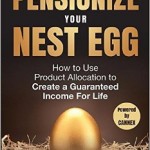Here’s my latest MoneySense blog, entitled The case for tontines: part 2. It follows Part 1, which ran a week ago both at MoneySense.ca and here at the Hub: Tontine: Retirement Plan of the Future?
After the first piece ran and even after reading both of Milevsky’s two latest books from cover to cover — one is essentially about annuities, the other about tontines — I realized I was still hazy about the exact difference between life annuities and tontines. I figured that if I was a little uncertain, so would many readers be.

Moshe responded with a quick clarification of the two major differences, as well as sending me a recent presentation he made that touched on both concepts. Whether all these concepts could be incorporated into the ongoing debate about an expanded and voluntary CPP remains to be seen, but see today’s other guest blog by Pierre Laporte, entitled Voluntary CPP is an old idea … has its time finally come?
Not anywhere near as old as tontines, mind you!
For archival and one-stop shopping purposes, we also show the blog below, with a few subheads and images added:
Tontines vs Life Annuities: What’s the difference?
By Jonathan Chevreau
 Last week in this space, we looked at a Medieval risk-sharing concept called the Tontine, as reprised by finance professor Moshe Milevsky in his recently published book, King William’s Tontine.
Last week in this space, we looked at a Medieval risk-sharing concept called the Tontine, as reprised by finance professor Moshe Milevsky in his recently published book, King William’s Tontine.
The prolific Milevsky, in concert with certified financial planner Alexandra MacQueen, recently also published the revised international edition of Pensionize Your Nest Egg. A must-read for anyone lacking a DB pension, the new edition is aimed not just at Canadians but also English speakers in the United States, the United Kingdom, Australia and New Zealand.
We’ll look at it in more detail in an upcoming column but suffice it to say for now that Milevsky makes a distinction between a real pension – the Defined Benefit pension on offer by employers and also government benefits like CPP and OAS – and capital-appreciation vehicles like RRSPs, TFSAs and even Defined Contribution pensions. The latter he does not consider true pensions, which must have an element of a guarantee of lifetime income, or at least “highly predictable” income for life.
Build your own pension plan
The book chiefly describes how these capital appreciation vehicles can be converted to true pensions, making it useful for anyone who doesn’t have a gold-plated inflation-indexed employer-sponsored DB plan. And the main vehicle he mentions is life annuities.
 But what about tontines? Strangely, despite his writing an entire book about tontines, the word does not appear in either edition of Pensionize Your Nest Egg. Although, as co-author Alexandra MacQueen pointed out after the MoneySense version of this blog ran, the tontine “concept” did appear in the example of Great Grandma’s Poker Table Bet on pages 81 to 84.
But what about tontines? Strangely, despite his writing an entire book about tontines, the word does not appear in either edition of Pensionize Your Nest Egg. Although, as co-author Alexandra MacQueen pointed out after the MoneySense version of this blog ran, the tontine “concept” did appear in the example of Great Grandma’s Poker Table Bet on pages 81 to 84.
But what exactly is the difference between annuities and tontines?
I pressed the busy Milevsky for his definition of the difference and here’s his reply, via email:
“The difference between the tontine and the annuity is that with a life ANNUITY there is someone standing behind the ‘deal’ guaranteeing the payments. This requires capital and is costly. For example, if people live longer than anticipated the sponsor has to make extra payments. On the other hand, with a TONTINE the group itself shares in the risk. If people live longer, the payment is reduced to the entire group. So, while this introduces a certain element of uncertainty to the group as a whole, the reduction in cost — due to the reduced need for capital and reserves — makes it a viable competitor to the ANNUITY.”
Milevsky also elaborated on the difference in a recent presentation for the IFID Centre, entitled Designing Longevity Insurance for the 21st Century.
There he said that with a tontine, the total interest paid each year to those within the group stays constant, while with a life annuity, as people die, the total paid out to the group declines over time.
The second difference
A second distinction is that with a tontine, payments to survivors increase … and the longer they live the more they get! By contrast, with a life annuity, payments and income to survivors stay constant.
Citing Adam Smith, Milevsky says the tontine “appeals to the gambling instinct” – the same confidence that frequent buyers of lottery tickets seem to exhibit, despite the poor odds of winning. As Smith said, the tontine annuity “generally sells for something more than it is worth.”
TIAA-CREF uses a tontine-like system without using the word
In most of the world today tontines are no longer permitted, although Milevsky’s book makes the case for their revival in the 21st century. There he also notes that there are several countries that utilize the “tontine principle” in their pension plans, but don’t actually call them tontines. In fact, he adds, one of the largest pension systems I the world – New York City-based TIAA-CREF – uses a tontine-like system to adjust payouts.
Back in the 17th century, old age pensioners often had the choice of a tontine or a life annuity. Even though the tontine in England in 1693 paid only 8% and a life annuity paid 14%, the promise of a bigger payoff if you outlived everyone else still caused some to choose the tontine, since like a lottery someone had to win. The winning nominee in King William’s Tontine of 1693 was a 100-year old female.
But what about 2015? Milevsky asked his audience to imagine a tontine-like product in which expected cash-flows increase at the rate of inflation, are capped at advanced ages, are homogeneous across demographic cohorts, and that require no capital. This means you may be able to get 10 or 15% more income on average, as long as you’re willing to share some demographic risk with your neighbour. “Remember, this isn’t stock market risk!”
His question for you, as well as the financial industry and its aging customers, is whether you would choose to “allocate” such a product as an alternative to a life annuity.
Jonathan Chevreau runs the Financial Independence Hub, and can be reached at jonathan@findependencehub.com


